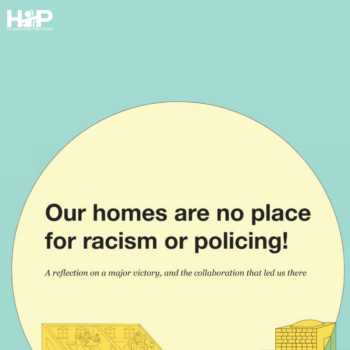| By Sara Satinsky |
A mandate of public health is to improve health equity, promote public safety, advance prevention, and strive for social justice.
With this in mind, as I process the results of the election and the uncharted, unprecedented future there is a whisper of a question that’s growing louder: what can public health do? We at Human Impact Partners work to carry out this public health mandate by partnering with movements on the front lines of policy change for social justice. Last year, we were privileged to partner with two knowledgeable and committed organizations—Ohio Justice & Policy Center and Ohio Organizing Collaborative—to research the health impacts of policing on Black communities and police officers.
The lessons I learned from this research project can help answer a piece of the question, at least. Below are four specific ways that public health can show up to work on policing reform:
- Collect data. Fill gaps in data nationwide about the mortality and morbidity attributed to police interactions. At the 2016 American Public Health Association meeting, we were honored to share reflections from the project in Ohio as part of a timely and thoughtful session on policing and public health data. Participants shared a collective sigh about the lack of mandatory, consistent, real-time data available nationwide from governmental datasets about police-involved incidents. In the meantime, non-governmental data from sources like the Guardian’s “The Counted” help fill gaps. There also are data reporting systems combing down the pike at a federal level, but they will continue to be voluntary. One approach that Dr. Nancy Krieger and colleagues are leading in Massachusetts calls for making police-involved deaths a notifiable condition. This is a great and actionable step well within the bounds of public health. More states need to work on making this happen. In addition to deaths, it will be important to capture the associated morbidity, as well as impacts to not only the individuals directly affected but those to households, families, and communities.
- Participate in local efforts. There are various ways that public health practitioners can participate in criminal justice reform work happening in their neighborhoods—the point is to participate. In the “Trust not Trauma” effort, staff from a public health department and from health policy groups joined the Advisory Committee guiding the project. Health departments also can lead making requests to police departments for data in a cross-agency cooperation. In a separate example of participating in local efforts, a pediatrician in the Bay Area of California played a large role in organizing fellow public health advocates to write a letter to the San Francisco Police Commission and Department about a public health response to violence during interactions with police.
- Fill research gaps. There is a new but small literature about how policing directly affects health. However, there are important gaps to fill, as described in this interview with Public Health Magazine. It includes direct connections from policing practices to not only physical, but also mental and emotional health. There are impacts to individuals involved in these interactions but also their households, families, and the public that witnesses events. The cumulative and long-term effects to these populations must be better understood if we are to grasp the full scope of impacts.
- Speak publicly, and often. Whether it’s being quoted in a press release—as a person who works at a public health department was in the Ohio project—or talking one-on-one with the public, legislators, law enforcement, media, or others, we in public health have a voice that is valuable, relevant, and powerful. So we need to speak. Work is building nationally both among professional organizations like the National Association of County & City Health Officials who publicly released a statement on Health, Racism, and Police Violence or the American Public Health Association’s statement on the Impact of Police Violence and Public Health, and in efforts by a variety of individuals to advance and publicize a collective vision to improve public health and criminal justice systems.
For more on the Ohio report, visit www.TrustNotTrauma.org.
This article was originally published on Public Health Post.





